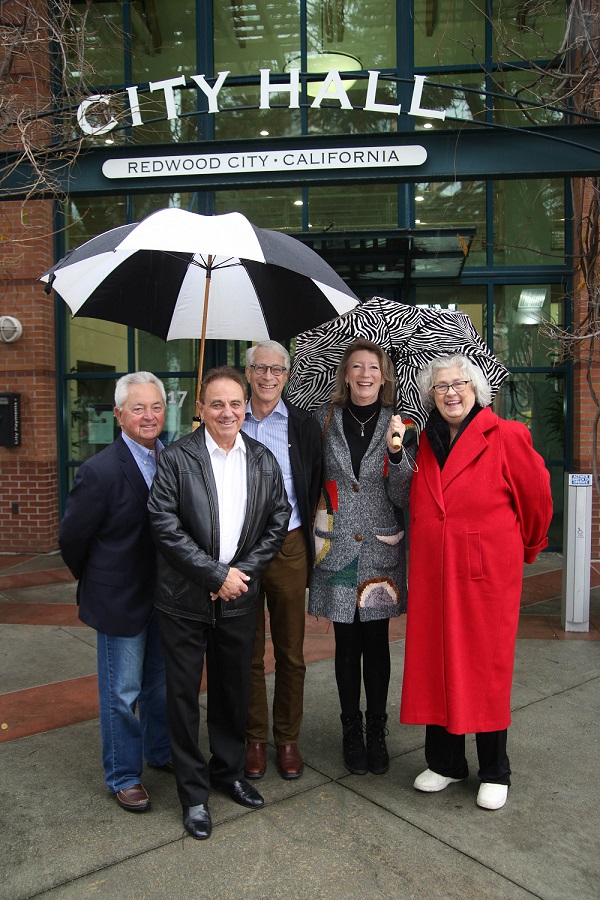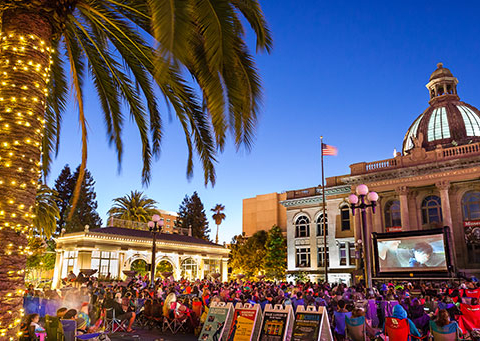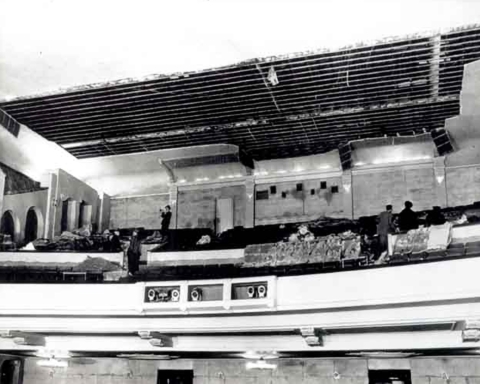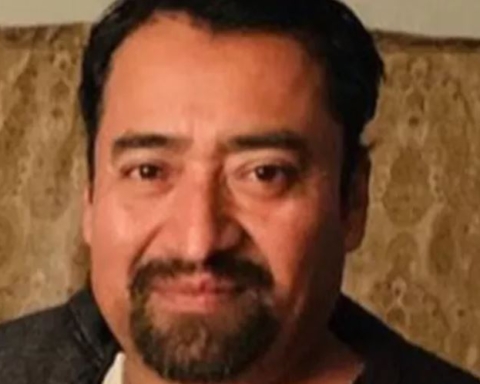In sports lingo, they might be called the “farm team” or the “junior varsity;” in the theater, the “understudies.” Except that, for the several dozen members of Redwood City’s all-volunteer boards and commissions, there’s no guarantee of moving up – and often not even a desire to. (At least at first.) They put in long hours before and during public meetings, do research, talk to city staffers, advance ideas, volunteer at city functions and perform other duties, assigned and otherwise.
“I love Redwood City, and if I’m lucky enough to be in a position to contribute, there’s a lot of satisfaction in doing that,” says Rick Hunter, whose attitude is typical of these off-the-clock public servants. “I’ve met a lot of people and it’s a great way to learn about the city and get involved.”
“Support-wise and all, I think we do make a difference,” adds Barb Valley, a book-loving Lockheed retiree who joined the Library Board six years ago. “I really feel like I’m engaged, like I’m doing something. And I love telling people about the library.”
Known around City Hall as “the BCCs,” there are over a dozen boards, committees and commissions, three of which (the Planning and Port Commissions and the Library Board) are required by Redwood City’s charter. The mission can be broad and obvious (the Civic Cultural or Parks, Recreation and Community Services commissions for example), or specific (the Board of Building Review deals with the Building Code and permit appeals and the Senior Affairs Commission with programs for the senior population.) The City Council appoints members of all the BCCs except for the Historic Resources Advisory and the Architectural Advisory committees, which are appointed by the Planning Commission.
Applicants must exhibit an interest in civic involvement, be a registered voter 18 or older and, with some exceptions, be residents of incorporated Redwood City. Some positions have additional requirements or preferred areas of expertise; for instance, only licensed architects who live or work in the Redwood City area can serve on the architectural committee, and members with relevant educational and professional expertise are sought for the historical body.

With two exceptions, BCCs serve advisory roles and don’t have decision-making power. (Planning Commission actions stand unless overturned on appeal to the City Council, and the Port Commission is autonomous.) Mayor Ian Bain and Vice Mayor Diane Howard, both of whom got their start on city commissions, say the BCC volunteers, who develop annual work plans for their groups, serve a critical advisory role and provide valued feedback.
Says Howard: “They are doing work the council would never have the time to accomplish. We could try. We can do a portion of it. But they do so much work and bring it back and we’re the beneficiaries of it because it helps us make better decisions.”
Vacancies seem to come in waves. The city went through one of its biggest recruitments over a year ago to fill 28 seats, but just made five more appointments in January. Recruiting is currently underway for three more positions.
In making appointments, Mayor Bain says he looks for experience relevant to the particular commission; diversity, including diversity of opinion; and “the right personality fit. People who we think are going to get along together. One bad apple can ruin the whole bunch.” For commissions with a heftier workload (Planning and the Port), often long-time residents or those with demonstrated prior service get the edge over those with a lesser track record.
Ralph Garcia, who owns Ralph’s Vacuum & Sewing Center on Main Street, had put in almost 11 years on the Planning Commission before being selected for the port board in 2005. “The first time I applied (for a commission) I was turned down, which is what usually happens. It was suggested that I get to know the council members.”
What motivates the volunteerism by this well-known downtown business leader might surprise people. The son of a single mother, Garcia grew up with unsupervised time on his hands and became a frequent denizen of juvenile hall. “I was not a well-behaved child and I felt sort of like I needed to give back to the community,” he says.
He and current Planning Commissioners Nancy Radcliffe and Ernie Schmidt feel good about years of volunteer efforts bearing fruit, such as in the downtown revival and the creation of Courthouse Square. “I recognize that the decisions we make, yes, could have significant impact,” says Schmidt, who has also run twice for City Council. He stressed the importance of community input in coming to decisions. “It’s not just about seven Planning Commissioners coming to a decision on their own. It really takes a village.”
Rightly or not, the Port and Planning commissions tend to be viewed as more prestigious, although many who end up on the City Council climbed up on other rungs (or not at all.) Planning Commissioners have a particularly heavy load, receiving mega-reading packets the Thursday before their twice-monthly meetings. “I always go out and walk the project,” says Radcliffe. “If you don’t see it in real life, how can you make a decision?” She says she hasn’t lost any friends because of her decisions, “but I’ve had people who have been mad at me for a bit.”
Though Mike Lynch acknowledges that “the stakes are much higher” at Planning Commission meetings, he still recalls how contentious things got several years ago when he was vice chairman of the Parks and Recreation Commission, when a trial dog park was proposed at Stulsaft Park to the consternation of some of the neighbors. After many years on that body, Lynch, 72, opted to switch to the Senior Affairs Commission about nine months ago. He acknowledges that “it’s probably viewed as a sleepier type of commission where there’s not as much going on” but says the group is focused on doing what’s best for seniors.
Hunter’s first foray into BCCs began years ago when a middle school cross country running program he started at his kids’ school went citywide. He got onto the parks commission and was enjoying it, but when an opening came up for an unexpired term on the Planning Commission a couple of years ago, he went for it. Hunter served for a year and a half and felt “pretty bad” when he didn’t get the votes to be reappointed.
Hunter ran for City Council last year and, after an agonizing seesawing count that ended three weeks after the November election, was edged out by Diana Reddy. Undaunted, Hunter applied for a Planning Commission vacancy, and, as of January is back on it.
“(It was) unanimous. Finally, an election that exceeded my expectations,” he says with a laugh. Hunter highly recommends commission service to others. “You may not get appointed. I know City Council members who say their involvement started with the boards and commissions and they didn’t get appointed, more than once.”
Former Mayor Dick Claire has been on both sides of the appointments process often enough to get whiplash. First named to the Planning Commission in 1978, he got off in 1982 when he was elected to the City Council, serving two decades, with a one-year break. “I retired from the council in 2003 and 22 days later I was a Planning Commissioner again. They had reduced the terms to three years instead of four. There were some (commissioners) they didn’t really like and wanted to be able to move them off gracefully.”
He moved to the Port Commission in 2007 in part because he was upset about the port being stuck with the multi-million-dollar clean-up cost of a former fuels tank farm on port-owned land. He’d like to stick it out long enough to see the nine-acre site redeveloped and generating revenue and notes that a developer is eyeing it for a warehouse.
In an effort to ensure that the various BCCs are working in synch with the council, Mayor Bain has each prepare a work plan that responds to the city’s seven strategic priorities. “I see myself as the leader of the volunteers. … I need to provide direction and guidance and a framework to operate, the same as you would in a corporation.” That said, “I love it when people don’t agree with me and they provide a different perspective. I want to hear those ideas and have a discussion.”
There is occasional discord between council and BCC members, which factored into a charter change on the November ballot asking voters to set term limits for commissioners, like City Council members. The measure passed and the BCCs are now limited to four consecutive four-year terms.
“I’ve never believed in term limits,” Claire counters. “I voted against a lot of individuals. If you want to get rid of a commissioner, you just vote them off.”
Ken Rolandelli is nearing 40 years of service on the Historic Resources Advisory Committee (up there with Port Commissioner Dick Dodge), with a year left in his term. Thanks to his committee’s efforts, the city has a historic preservation ordinance, and has designated a number of landmarks and historic districts. The Diller Chamberlain store at 726 Main St., Redwood City’s most historically important building, would have been razed after the 1989 earthquake were it not for the committee, according to Rolandelli.
“There’s a lot of notches on the belt. We’ve had a lot of successes. Yeah, it’s gratifying to me.”
Rolandelli says it’s hard enough to find people to serve on the historic resources committee, let alone qualified applicants with expertise and training. “Just getting someone who likes old stuff isn’t going to do it,” he says.
Steve Howard, the physician-husband of the vice mayor, served for many years on the Architectural Review Committee, filling a spot for a citizen at large. Initially only an advisory body, the board managed to get elevated to an integral part of the review process, and “I think the good developers actually appreciated it. … And I think at the end of the day, most of them thought they ended up with a better project.” It can be hard for professionals in the same field to be candid about others’ work, he adds. “I didn’t have that problem. I was much more blunt.”
He quit the committee several years ago when its role was cut back and the “review” committee became the Architectural Advisory Committee. It now meets “as needed.”
“It was a very pro-development council at the time and I think they felt that we were slowing the process and they wanted to speed it up,” Howard says. “They decided that it should be an advisory committee to planning. So basically you don’t do anything unless planning asks you to take a look at this. And I just felt that they cut us off at the knees. I wrote them a letter and said I can’t be part of this process. I think you’ve done a disservice to the community.”
Diane Howard got her start in city government long ago when she was appointed to the Housing and Human Concerns Committee. Running for office someday hadn’t even entered her mind, but to anyone thinking of doing so Howard always suggests a board, committee or a commission as a first step: “It lays the foundation for how does government work? Who are the players? I learned so much in those first 10 years, I wouldn’t trade it.”
Michael Smith is a relative newcomer both to the city and the Planning Commission, which he joined last June. A management consultant who works with small- to medium-sized companies, Smith lived previously in Harlem, New York, which he says is experiencing issues familiar to Redwood City, among them changing demographics, income levels and “shifting of the landscape.” Smith, who is also an adjunct assistant business professor at Cañada College, looked for ways he could contribute after he relocated almost three years ago. He is trying to “give voice” to people in the community who might not have one.
Smith, 34, joined a church and got involved in several nonprofit organizations, as well as the city’s advisory committee on the plan for El Camino Real. A renter, he’s also co-chair of the Palm Park Neighborhood Association.
“The people of Redwood City are extremely welcoming,” he says. Not only has he never received any kind of pushback, that’s what drove him to feel that a relative newcomer could serve on a commission alongside long-time residents. “I truly believe that, especially in Redwood City, people are interested in making lives better,” he says. “I don’t think it’s a question of wanting to do it but knowing how.”
This story was published in the March print edition of Climate Magazine.






